Breastfeeding in public
The social attitude and legal status regarding the practice of breastfeeding in public vary widely in cultures around the world. In many countries, both in the Global South and in a number of Western countries, breastfeeding babies in open view of the general public is common and generally not regarded as an issue. In those countries, laws protect the nursing mother. In many parts of the world including Australia,[1] some parts of the United States, and Europe, along with some countries in Asia, women have an explicit legal right to nurse in public and in the workplace.
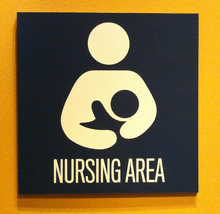
Even though the practice may be legal or socially accepted, some mothers may nevertheless be reluctant to expose a breast in public to breastfeed[2][3] due to actual or potential objections by other people, negative comments, or harassment.[4] It is estimated that around 63% of mothers across the world have publicly breast-fed.[5] The media have reported a number of incidents in which workers or members of the public have objected to or forbidden women breastfeeding.[6] Some mothers avoid the negative attention and choose to move to another location. But some mothers have protested their treatment, and have taken legal action or engaged in protests.[7] Protests have included a public boycott of the offender's business, organizing a "nurse-in" or a breastfeeding flash mob, in which groups of nursing mothers gather at the location where the complaint originated and nursed their babies at the same time. In response, some companies have apologised and agreed to train their employees.[8]
Attitudes by country and continent
Africa
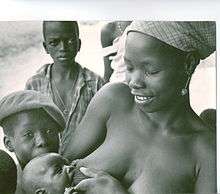
In many areas of Africa breastfeeding in public is the norm. Babies are commonly carried on a mother's back in a length of cloth and merely moved to the front for feeding. The nursing mother may shield the view of the baby nursing, but generally no attempt is made to hide the baby and the mother's breast from view. When a baby is seen crying in public it is assumed that the woman with the infant is not the child's mother, since it is normally thought that she would feed the infant if she were the mother.[9]
Morocco
Public breastfeeding is legal and widely accepted.[10]
Sierra Leone
Sierra Leone has the highest infant mortality rate in the world. During a goodwill trip to the country, actress Salma Hayek breastfed on camera a hungry week-old infant whose mother could not produce milk.[11] She said she did it to reduce the stigma associated with breastfeeding and to encourage infant nutrition.[12]
Asia
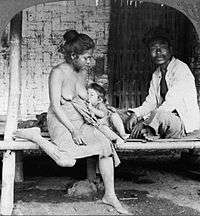
China
Breastfeeding in public in China has traditionally been uncontroversial, and objection had been unheard of until 2010s. The recent few instances of objection are apparently an effect of magnification of the social media.
In Shanghai, breastfeeding in public is considered embarrassing by some, but it is also accepted by many. There have been calls for the establishment of babycare facilities in public places.[13][14]
India
India has no legal statute dealing with breastfeeding. Prevalence and social acceptance vary from region to region. In rural India it is completely acceptable. Breastfeeding in public is not a norm in higher sections of society, but is quite common in the lower economic sections.
Malaysia
Discreet breastfeeding in public is accepted in Malaysia.[15]
Nepal
Nepal has no laws about public breastfeeding. Public breastfeeding is common and widely accepted.[16] It is not uncommon to see mothers breastfeeding their babies in public places such as buses, parks, restaurants, hospitals etc. in Nepal. In Nepalese society, breastfeeding a child is considered a must for the mothers. Mothers who do not or are unable to breastfeed their child are considered to be 'bokshi' – 'witch', and much social stigma is attached to it.
Philippines
In the Philippines, breastfeeding is protected by various laws, such as the Expanded Breastfeeding Promotion Act of 2009[17] and the Milk Code of the Philippines (Executive Order 51).[18] Mothers are allowed to breastfeed in public. Employers are required to allow lactating employees breaks to breastfeed or express breastmilk. The law also states that the intervals should not be less than a total of forty (40) minutes for every eight (8) hour working period.[19] Offices, public establishments such as malls and schools, and government institutions are required to establish lactation stations separate from the bathroom, where mothers can breastfeed their babies or express milk. The Milk Code prohibits the advertising of infant formula or bottle teats for infants under two years old.[20]
Saudi Arabia
Even though women can not show any part of their body in public, breastfeeding is an exception. It is common for women to breastfeed in malls and parks, and it is acceptable among the people in Saudi Arabia.[21]
Taiwan
Since November 2010 the Public Breastfeeding Act has safeguarded the right to breastfeed in public, while lactation rooms are set up to deal with privacy and to provide access to hot water and power supplies, with fines against interfering with a mother's right to breastfeed.[22] After evicting a breastfeeding mother from the National Palace Museum on 18 July 2012 and enraging many Taiwanese website users,[23] the supposedly offending employee and her employer were both fined 6000 new Taiwan dollars (about 200 United States dollars), said the Department of Health, Taipei City Government (Chinese: 臺北市政府衛生局), but the Museum would appeal.[24]
Europe
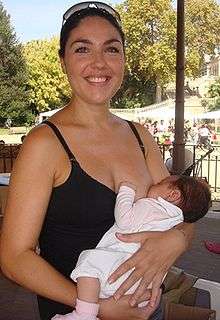
Czech Republic
Although public breastfeeding is often practised and is not illegal, some people disapprove of it.
France
Public breastfeeding is legal and widely accepted.
Germany
While public breastfeeding is widely accepted, especially since the Movement of 1968 when public "Nurse-Ins" (German: Still-Inns) were common, there is no legislation that specifically addresses breastfeeding in public.[25]
Paragraph 2 Article 6 of the Basic Law for the Federal Republic of Germany provides that "the care and upbringing of children as the natural right of parents" while paragraph 4 "entitles every mother to the protection and care of the community".[26]
Iceland
Public breastfeeding is widespread and uncontroversial.[27]
Italy
In Italy, public breastfeeding is legal and accepted by many. In Italy many mothers do not comply with breastfeeding recommendations. The promotion and support of breastfeeding is still necessary in Italy and still needs to be monitored with representative data. Actions should aim at empowering women, reducing social inequalities and improving practices in hospitals and maternal care services which encourage breastfeeding. [28]
Ireland, Republic of
In the Republic of Ireland, breastfeeding wherever necessary is protected by law under the Equal Status Act (2000), which protects people from discrimination and harassment (including sexual harassment). Although breastfeeding is not directly mentioned, protection for breastfeeding in public is covered by the Act on gender grounds. As a result it is an offence to ask a breastfeeding woman to stop, move somewhere else or cover up, for example.
While this gives a legally protected right to breastfeed anywhere that it becomes necessary Ireland has one of the lowest rates of breastfeeding in the world.
Netherlands
Public breastfeeding is common and widely socially accepted. There are no laws against public breastfeeding. Dutch law states that when an employee wishes to breastfeed her baby the employer must provide, for the first nine months after the birth, a suitable nursing room and allow for 25% of work time to be spent on feeding the baby or pumping while on pay. After the first nine months the employer is still required to assure conditions for breastfeeding are met (like timely breaks, nursing rooms, safe environment, etc.) but does not have to pay anymore for the time spent on breastfeeding or pumping.[29]
Norway
Public breastfeeding is widespread and uncontroversial.
Poland
Public breastfeeding is widespread and uncontroversial.
Spain
Public breastfeeding is legal and widely accepted.
United Kingdom
Breastfeeding in public (restaurants, cafes, libraries etc.) is protected under the Sex Discrimination Act 1975 under the provision of goods, facilities and services section. If the child is under six months old, the mother has additional protection under a 2008 amendment to the act which protects maternity rights. This is superseded by the Equality Act 2010 which clarifies that a business must not discriminate against a woman who is breastfeeding a child of any age in a public place.[30][31] Her companion(s) are also protected by this act.
A 2004 UK Department of Health survey found that 84% (about five out of six people) find breastfeeding in public acceptable if done discreetly; however, 67% (two out of three) of mothers were worried about general opinion being against public breastfeeding.[32] To combat these fears in Scotland, the Scottish Parliament passed legislation safeguarding the freedom of women to breastfeed in public in 2005.[33] The legislation allows for fines of up to £2500 for preventing breastfeeding of a child up to the age of two years in public places,[34][35]
Vatican City
In 2014 during a ceremony commemorating the baptism of Jesus, Pope Francis voiced his support for mothers breastfeeding their children in public spaces, including churches. On 9 January 2017 he reiterated his support for public breastfeeding.[36][37]
North America
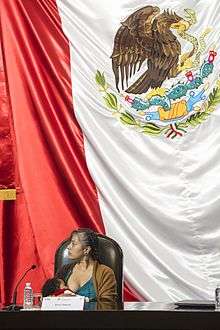
Canada
In Canada, Section 28 of the Canadian Charter of Rights and Freedoms gives equal rights and freedoms to men and women, without explicitly mentioning breastfeeding. Both British Columbia[38] and Ontario[39] have included protections against discrimination due to breastfeeding in their provincial Human Rights Codes. In both provinces, discrimination due to breastfeeding is included in existing protections against discrimination based on sex. INFACT Canada (Infant Feeding Action Coalition) is a national non-governmental organization that aims to protect infant and young child health as well as maternal well-being through the promotion and support of breastfeeding and optimal infant feeding practices.[40] It is an organization that provides support and education for Canadian mothers.
A woman asked in 2009 at a shop by an employee to stop breastfeeding publicly, supported by a manager, later received an apology and acknowledgement of customers' right to breastfeed.[41] A worker at the YMCA in St. John's told a breastfeeding mother to leave the premises. The mother was feeding her seven-month-old daughter in a private change room, which required a monthly fee. YMCA CEO Jason Brown later apologized, stating "This situation has caused us to reflect and review, and certainly we see no reason why there should be a restriction to women breastfeed their babies in the adult-only change room."[42]
Inuit people
Inuit children have the lowest breastfeeding rates amongst Canadian Aboriginal populations, far lower than the Canadian average. According to a 2006 statistics report, 24% of Inuit children have never been breastfed. There have been health promotion programs created in order to increase the knowledge of the benefits of breastfeeding amongst Inuit women.[43]
United States
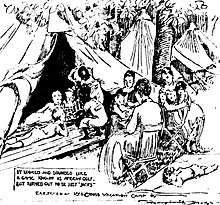
A number of issues constrain mothers from breastfeeding in public in the United States. In 2011 the US Surgeon General issued a plea to promote breastfeeding and stated in it: "Although focusing on the sexuality of female breasts is common on the mass media, visual images of breastfeeding are rare, and a mother may never have seen a woman breastfeeding".[44] Another issue, especially in extended breastfeeding, is that US medical providers are not well-trained in supporting breastfeeding mothers. In a survey of medical professionals published in 2012, including physicians, midwives, residents, and nursing students, only 57.8% felt that breastfeeding over 1 year of age was normal.[45] The recommendations for breastfeeding are until at least one year, yet in 2016 the Centers for Disease Control and Prevention (CDC) reported that only 51.8% of infants were breastfed at six months and 30.7% of infants were being breastfed at one year old.[46]
In a 2004 survey conducted by the American Dietetic Association, 43% of the 3,719 respondents believed women ought to have the right to breast-feed in public.[47] In spite of this, women breastfeeding in public have met with social resistance and even arrest.[48] In some public places and workplaces, rooms for mothers to nurse in private have been designated.
U.S. legislation governing breastfeeding varies from state to state and a limited federal law only applies to federal government premises. A United States House of Representatives appropriations bill (HR 2490) contained an amendment specifically permitting breastfeeding[49] and was signed into law on September 29, 1999. It stipulated that no government funds may be used to enforce any prohibition on women breastfeeding their children in federal buildings or on federal property. Further, a federal law also enacted in 1999 specifically provides that "a woman may breastfeed her child at any location in a federal building or on federal property, if the woman and her child are otherwise authorized to be present at the location."[50]
Section 4207 of the Patient Protection and Affordable Care Act amended the Fair Labor Standards Act and required employers to provide a reasonable break time for an employee to breastfeed her child if it is less than one year old.[51] The employee must be allowed to breastfeed in a private place, other than a bathroom. The employer is not required to pay the employee during the break time.[51] Employers with fewer than 50 employees are not required to comply with the law if doing so would impose an undue hardship to the employer based on its size, finances, nature, or structure of its business.[52]
A number of incidents of harassment of nursing mothers that gained media attention prompted a number of U.S. states to act. These actions included viral videos of people harassing breastfeeding mothers in public, protests, and social media campaigns. A particular incident with a Target employee harassing a breastfeeding mother helped to launch a new trend with corporations making breastfeeding accepted in their stores.[53]
As of July 2018, all 50 states, the District of Columbia, and the Virgin Islands have passed legislation that explicitly allows women to breastfeed in public.[54] Further, at least 29 states, the District of Columbia, and the Virgin Islands exempt them from prosecution for public indecency or indecent exposure for doing so.[55]
Oceania
Australia
Section 7AA of the Sex Discrimination Act 1984 specifically prohibits discrimination against a woman on account of her breastfeeding.[56] The prohibition also applies to a public or semi-public place. State and Territory laws differ, but it is generally illegal to discriminate against women breastfeeding in a public place as a protected attribute in five jurisdictions and by proxy from other existing legislation in the other jurisdictions.[57]
The Australian Breastfeeding Association was founded in Melbourne, Victoria in 1964 as the Nursing Mothers' Association, and together with many health professionals, encourages and assists mothers to breastfeed their babies, if necessary also in a public place.[57]
In February 2003, Kirstie Marshall, member of the Victorian Legislative Assembly, was ejected from Parliament for breastfeeding her 11-day-old baby on the basis that the baby was "a stranger" not entitled to be in the Chamber. As a result, a special room was set up for use by nursing mothers. A 2007 House of Representatives Committee on Health and Ageing report into breastfeeding recommended that Parliament House seek formal accreditation from the Australian Breastfeeding Association as a breastfeeding-friendly workplace. In March 2008 the Presiding Officers agreed to the recommendation and work commenced to provide facilities to assist breastfeeding mothers at Parliament House. Two small rooms were made available, one on each side of Parliament House, for members of parliament and other building occupants to breastfeed or express milk. Certificates of accreditation were provided in a ceremony at the parliament on 17 October 2008.[58]
New Zealand
Breastfeeding is encouraged and public breastfeeding is common. In fact, bottle feeding has been so widely discouraged that public bottle feeding may make a mother feel more uncomfortable than public breastfeeding. Many shopping centers provide "parent's rooms" where mothers may change and feed their infants in comfort.[9]
South America
.jpg)
In most areas of South America breastfeeding is the norm and public breastfeeding is common in buses, parks, malls, etc. It is less common to see public bottle feeding than breastfeeding. While women are seldom seen nursing in upscale restaurants or on the streets of large cities, nursing is encouraged and thought of as normal and a nursing mother's breasts are not viewed as sexual objects.[9]
Recent controversies
Breastfeeding at work in Canada
Under the Canadian Charter of Rights and Freedoms women are protected against discrimination, but Canada was one of the only countries that did not have paid breastfeeding breaks. Although over 26% of mothers breastfeed, many of them are forced to stop due to work restrictions.[59]
Public breastfeeding in the U.S.
There have been incidents of owners of premises, or people present, objecting to or forbidding breastfeeding. In some cases the mothers have left. In other cases, where a law guaranteeing the right to breastfeed has been broken, legal action has been taken.[60] Some companies have even apologised afterward.[8] One woman who was not allowed to breastfeed despite showing the Kentucky law that allows her the right,[61] left but later organized several "nurse-in" protests in front of the restaurant and other public places.[62]
In June 2007, Brooke Ryan was dining in a booth at the rear of an Applebee's restaurant when she began to breastfeed her seven-month-old son. Although she attempted to be discreet, another patron complained to the manager about indecent exposure. Both a waitress and the manager asked her to cover up. She handed him a copy of the Kentucky law that permitted public breastfeeding, but he would not relent. She opted to feed her son in her car, and later organized "nurse-out" protests in front of the restaurant and other public locations.[63] Most U.S. states (49 as of September 2015) have laws clarifying a woman's right to breastfeed in public.[64]
In 2008 a woman in New Orleans put a tent over her truck at a street festival so she could nurse her daughter privately. She was cited by police for an "unauthorized booth" and removed from the street festival.[65][66][67]
Babytalk magazine cover
In 2006, the editors of U.S. Babytalk magazine received many complaints from readers after the cover of the August issue depicted a baby nursing at a bare breast. Even though the model's nipple was not shown, readers—many of them mothers—wrote that the image was "gross". In a follow-up poll, one-quarter of 4,000 readers who responded thought the cover was negative. Babytalk editor Susan Kane commented, "There's a huge puritanical streak in Americans."[47]
Barbara Walters
In 2005 U.S. television presenter Barbara Walters remarked on her talk show The View that she felt uncomfortable sitting next to a breastfeeding mother during a flight. Her comments upset some viewers who began organizing protests over the internet. A group of about 200 mothers staged a public "nurse-in" where they breastfed their babies outside ABC's headquarters in New York.[68]
Target store protest
In December, 2011, Michelle Hickman was breastfeeding her infant at the back of a Target store in Houston, Texas. Although covered, she was asked by two employees to move to a fitting room. Hickman said one of the employees told her, "You can get a ticket and be reported for indecent exposure." She reported the harassment on Facebook, and in response a number of mothers organized public "nurse-ins" at Target stores across the United States in cities including Houston, Knoxville, and Decatur, Illinois.[69] Trace Gallagher on FoxNews reported on the protest, and female host of America Live Megyn Kelly commented, “You know, I got a lot of thoughts on this, Trace.” She explained, “Let me just put it this way: I used to feel a lot differently before I had babies and you’re breastfeeding; they need to be fed and then sometimes they don’t like the cover. And before you know it, you're Megyn Kelly and you’re showing your breasts to a whole plane.”[70]
Claridge's hotel
In 2014 a waiter at Claridge's hotel in Mayfair, London asked Louise Burns to breastfeed under a cloth. Burns was told that it was hotel policy for mothers to cover up while breastfeeding. UK politician and broadcaster Nigel Farage spoke out in support of the hotel's right to have such a policy[71] but the Prime Minister's office at 10 Downing Street said it was "totally unacceptable for any women to be made to feel uncomfortable when breastfeeding in public". A group of about 25 mothers held a protest against the policy by breastfeeding outside the hotel.[72] Claridge's subsequently denied that asking breastfeeding mothers to cover up was hotel policy[71] and said that breastfeeding mothers were welcome at the hotel, adding: "all we ask is that mothers are discreet towards other guests".[73]
Breastfeeding in uniform in the US military
In May 2012, two Air Force National Guard service members stationed at Fairchild Air Force Base, Washington, participated in a breastfeeding awareness campaign hosted by the Mom2Mom of Fairchild Breastfeeding Support Group. Photographer Brynja Sigurdardottir, also a military spouse, staged and photographed Terran Echegoyen-McCabe and Christina Luna breastfeeding in uniform. Crystal Scott, the founder of Mom2Mom, said people thought the photograph was a disgrace to the uniform and compared their actions to defecating or urinating in uniform.[74] Some military personnel felt that it was impossible for a woman to maintain a professional military bearing while nursing in uniform.[75] But some active-duty veteran military members who are also mothers were more supportive, suggesting that the women enhanced the prestige of the military.[76] The photographs quickly went viral and were shared worldwide. To help reduce the controversy, Sigurdardottir removed the photos from her website and Facebook fan page. Her intention was to raise awareness and support for women who breastfeed, inside and outside of the military. When the controversy arose, the message was quickly lost among critics.
While the U.S. Air Force did not endorse the pictures, their commanding officer gave the women permission to be photographed in uniform while breastfeeding.[75] The U.S. military protects women in uniform by allowing them to defer deployments for 4 to 12 months after childbirth for breastfeeding purposes. Breastfeeding service members are provided regular breaks to breastfeed or pump while on duty, and are provided with a comfortable and private place to do so.[76]
Facebook controversy
Facebook has been criticized for removing photos of mothers breastfeeding their children, citing offensive content in violation of the Facebook Terms of Service.[77] Facebook claimed that these photos violated their decency code by showing an exposed breast, even when the baby covered the nipple. This action was described as hypocritical, since Facebook took several days to respond to calls to deactivate a paid advertisement for a dating service that used a photo of a topless model.[78]
The breastfeeding photos controversy continued following public protests and the growth in the online membership in the Facebook group titled "Hey, Facebook, breastfeeding is not obscene! (Official petition to Facebook)."[79] In December 2011 Facebook removed photos of mothers breastfeeding and, after public criticism, restored them. The company said it had removed the photos because they violated the pornographic rules in the company's terms and conditions.[80] During February, 2012, the company once again removed photos of mothers breastfeeding. Founders of a Facebook group "Respect the Breast" reported that "women say they are tired of people lashing out at what is natural and what they believe is healthy for their children."[81]
See also
- History and culture of breastfeeding
- Child's Right to Nurse Act
- International Breastfeeding Symbol
- Simple living
- Women's Equality Day
References
- "Breastfeeding in public – your legal rights". Australian Breastfeeding Association. Aug 2016. Retrieved 12 Nov 2018.
- Wolf, J.H. (2008). "Got milk? Not in public!". International Breastfeeding Journal. 3 (1): 11. doi:10.1186/1746-4358-3-11. PMC 2518137. PMID 18680578.
- Vance, Melissa R. (June–July 2005). "Breastfeeding Legislation in the United States: A General Overview and Implications for Helping Mothers". LEAVEN. 41 (3): 51–54. Archived from the original on 2007-03-31. Retrieved 2008-12-30.
- Jordan, Tim; Pile, Steve, eds. (2002). Social Change. Blackwell. p. 233. ISBN 9780631233114.
- Cox, Sue (2002). Breast Feeding With Confidence. United States: Meadowbrook Press. ISBN 978-0684040059.
- "Places Moms Have Been Shamed For Breastfeeding". Huffington Post. September 18, 2012. Archived from the original on 29 September 2015. Retrieved 28 September 2015.
- "Dawn Holland, Breastfeeding Mom, Asked To Nurse In Applebee's Bathroom". Huffington Post. September 18, 2012. Archived from the original on 29 September 2015. Retrieved 28 September 2015.
- "Legoland Apologizes To Kelly Sabourin, Breastfeeding Mom Told To Move". February 3, 2012. Archived from the original on 29 September 2015. Retrieved 28 September 2015.
- "Breastfeeding in public around the world". 007 Breasts. Archived from the original on 8 October 2014. Retrieved 15 October 2014.
- Hargraves, Orin (2010). Morocco: A Survival Guide to Customs and Etiquette. Marshall Cavendish. p. 108. ISBN 9789814435895. Archived from the original on 2018-01-26.
- Thomson, Katherine (February 10, 2009). "Salma Hayek Breastfeeds African Baby (VIDEO)". Huffingtonpost.com. Archived from the original on April 28, 2009. Retrieved May 10, 2009.
- "Celebs Who Breastfeed in Public". Archived from the original on June 14, 2013. Retrieved August 1, 2001.
- "Congress to consider privacy issue". chinadaily.com.cn. Archived from the original on 2009-03-07.
- "Breastfeeding in public". chinadaily.com.cn. Archived from the original on 2009-06-20.
- "BabyCenter mums' tips for breastfeeding in public". BabyCenter. Malaysia. Archived from the original on 2012-05-27.
- Komodiki, E; Kontogeorgou, A; Papastavrou, M; Volaki, P; et al. (6 November 2014). "Breastfeeding in Public: A Global Review of Different Attitudes towards It". Journal of Pediatrics and Neonatal Care. 1 (6). doi:10.15406/jpnc.2014.01.00040. ISSN 2373-4426.
- "R.A. No. 10028". lawphil.net. Archived from the original on 2016-03-05.
- "E.O. No. 51". lawphil.net. Archived from the original on 2011-10-28.
- "Chronicles of a Nursing Mom: More on the Legal Rights of Breastfeeding and Working Women". chroniclesofanursingmom.com. Archived from the original on 2015-04-02.
- "Executive Order No. 51 – Philippine Commission on Women". pcw.gov.ph. Archived from the original on 13 December 2016. Retrieved 21 December 2016.
- Riordan, Jan (2005). "The Cultural Context of Breastfeeding". Breastfeeding and Human Lactation. Sudbury, Mass.: Jones and Bartlett. pp. 718–719. ISBN 978-0-7637-4585-1. Archived from the original on 2018-01-26.
- "Public Breastfeeding Act". Ministry of Justice (Republic of China). 2010-11-24. Archived from the original on 2012-07-10. Retrieved 2011-08-26.
- Liu Yunting (July 23, 2012). "Taipei Museum Faces Investigation for Evicting Breastfeeding Mother". Translated from Shenzhen Evening News. All-China Women's Federation. Archived from the original on January 26, 2018. Retrieved August 14, 2012.
- "Taiwan museum fined for stopping breastfeeding mum". From AFP, posted at Borneo Post Online. August 15, 2012. Archived from the original on March 5, 2016. Retrieved August 14, 2012.
- "Ist Stillen in der Öffentlichkeit obszön?" [Is Breastfeeding in Public Obscene?]. T-Online (in German). 8 February 2013. Archived from the original on 10 October 2011.
- "Basic Law for the Federal Republic of Germany (Grundgesetz, GG)". Article 6, Act of 23 May 1949. Archived from the original on 23 March 2017. Retrieved 31 August 2017.
- "Taking care of children in Iceland". www.nordicmum.com. Archived from the original on 10 October 2016. Retrieved 20 November 2016.
- Lauria, L., Spinelli, A., & Grandolfo, M. (2016). Prevalence of breastfeeding in Italy: a population based follow-up study. Annali Dell’istituto Superiore Di Sanita, 52(3), 457–461. https://doi.org/10.4415/ANN_16_03_18
- "Borstvoeding.com: kenniscentrum voor borstvoeding – artikelen- Borst & Baan – Borst & Baan en de wet". borstvoeding.com. Archived from the original on 2013-08-09.
- Equality Act 2010: What do I need to know? Archived 2013-12-31 at the Wayback Machine
- "Equality Act 2010". Office of Public Sector Information. 2010-04-08. Archived from the original on 2012-12-24. Retrieved 2010-08-27.
- "Myths stop women giving babies the best start in life" (Press release). UK Department of Health. 2004-05-10. Archived from the original on 2004-05-19. Retrieved 2007-02-16.
- "Breastfeeding etc. (Scotland) Act 2005". Queen's Printer for Scotland. 2005-02-10. Archived from the original on 2007-05-04. Retrieved 2007-01-24.
- "MSPs approve breastfeeding move". BBC News. 2004-09-23. Archived from the original on 2006-06-13. Retrieved 2007-01-24.
- "The Breastfeeding etc. (Scotland) Act 2005: Advice for Employers". scotland.gov.uk. Archived from the original on 2013-12-31.
- Rebecca Hersher (9 January 2017). "Pope Francis Reiterates Support For Public Breastfeeding". National Public Radio. Archived from the original on 9 January 2017. Retrieved 9 January 2017.
- Samantha Schmidt (9 January 2017). "Go Ahead And Breastfeed Pope Francis Tells Mothers In Sistine Chapel". The Washington Post. Archived from the original on 9 January 2017. Retrieved 9 January 2017.
- "Sex discrimination – breastfeeding and expressing milk".
- "Policy on preventing discrimination because of pregnancy and breastfeeding".
- Sterken, Elisabeth. "INFACT Canada". Archived from the original on 4 January 2014. Retrieved 12 March 2014.
- "Walmart apologizes for asking B.C. mom to stop breastfeeding, Ann Hui, The Vancouver Sun 18 July 2009". Archived from the original on 15 January 2012.
- "YMCA changes breastfeeding policy following complaint". CBC News. Feb 28, 2014. Archived from the original on 19 March 2014. Retrieved 13 March 2014.
- Asuri, Sirisha; Ryan, Anna Claire; Arbour, Laura (2011). Early Inuit child health in Canada. Report 2, Breastfeeding among Inuit in Canada (pdf) (Report). Ottawa: Inuit Tapiriit Kanatami. pp. 5–8. Archived (PDF) from the original on 2017-10-27.
- The Surgeon General's call to action to support breastfeeding (PDF) (Report). U.S. Department of Health and Human Services. 2011. p. 13.
- Cockerham-Colas, Lauren; Geer, Laura; Karen, Benker; Michael A., Joseph (June 2012). "Exploring and influencing the knowledge and attitudes of health professionals towards extended breastfeeding". Breastfeeding Medicine. 7 (3): 143–150. doi:10.1089/bfm.2011.0027. PMID 21854294.
- Breastfeeding report Card (PDF) (Report). Centers for Disease Control and Prevention. August 2016. p. 2.
- "Eyeful of breast-feeding mom sparks outrage". Associated Press. 2006-07-27. Retrieved 25 November 2011.
- Copeland, CS (Mar–Apr 2014). "Feeding Frenzy: Efforts to Increase Breastfeeding in Arkansas Still Met With Resistance" (PDF). Healthcare Journal of Little Rock: 36.CS1 maint: date format (link)
- "Breastfeeding Amendment". Archived from the original on 2015-05-04. Retrieved 2008-12-30.
- "Treasury and General Government Appropriations Act, 2000". Retrieved 13 July 2012. section 647.
- Patient Protection and Affordable Care Act Archived 2011-07-06 at the Wayback Machine. Government Printing Office. Page 459.
- Landau, Elizabeth (April 9, 2010). "Breastfeeding rooms hidden in health care law". CNN. Archived from the original on September 24, 2015.
- "Target Employees Bully Breastfeeding Mom Despite Corporate Policy – Best for Babes". Best for Babes. 2011-12-14. Archived from the original on 2016-10-17. Retrieved 2016-12-10.
- "Breastfeeding in Public Is FINALLY Legal in All 50 States". PEOPLE.com. Retrieved 2018-08-08.
- "Breastfeeding State Laws". National Conference of State Legislatures. National Conference of State Legislatures. 2 September 2015. Archived from the original on 30 November 2015. Retrieved 3 December 2015.
- Sex Discrimination Act 1984, s.7AA Archived 2015-03-22 at the Wayback Machine.
- "Breastfeeding in public – your legal rights". Australian Breastfeeding Association. Archived from the original on 2012-11-01.
- "Children in the parliamentary chambers". aph.gov.au. Archived from the original on 2015-11-17.
- Heymann, Jody (7 Oct 2013). "Breastfeeding breaks at work pay off; Canada is in the minority of countries that do not guarantee women paid breaks to feed infants at work". The Ottawa Citizen. ProQuest 1439984164.
- Barsch, Sky (June 11, 2006). "Woman alleges she was kicked off Burlington flight for breast-feeding". Associated Press. Archived from the original on January 22, 2007. Retrieved 2007-01-24.
- "Summary of Enacted Breastfeeding Legislation Kentucky". Archived from the original on 10 February 2014. Retrieved 21 February 2014.
- "Applebee's, woman in dispute over breast-feeding". Archived from the original on 2008-01-01. Retrieved 2009-12-17.CS1 maint: BOT: original-url status unknown (link)
- "Breastfeeding Protest Targets Restaurant Chain". 10 September 2007. Archived from the original on 27 February 2014. Retrieved 21 February 2014.
- "50 State Summary of Breastfeeding Laws". National Conference of State Legislatures. November 2008. Archived from the original on 29 April 2009. Retrieved 7 January 2009.
- "Mom's Breastaurant". momsbreastaurant.org. Archived from the original on 2012-08-04.
- "Mom's Breastaurant", Catherine P. Businelle, Mothering, January/February 2008, p. 62
- "Milpitas woman creates retreat for nursing moms", Wes Bowers, Milpitas Post, August 14, 2008, p. 38
- "'Lactivists' Taking Their Cause, and Their Babies, to the Streets". The New York Times. 7 June 2005. Archived from the original on 2 April 2015.
- "Breastfeeding Moms Stage 'Nurse-In' Protest at Target Stores Worldwide". FoxNews. December 28, 2011. Archived from the original on 14 February 2012. Retrieved 10 February 2012.
- Jonathon M. Seidl. "Megyn Kelly Reveals Past Airplane Breastfeeding Flub On-Air". The Blaze. Archived from the original on 2012-01-07.
- Patrick Wintour; Rowena Mason (5 December 2014). "Nigel Farage says breastfeeding women should sit in a corner". The Guardian.
- "Claridge's breastfeeding row: Protest by mothers". BBC News. 6 December 2014.
- "Claridge's says it welcomes breastfeeding after 'shroud' tweet". BBC News. 2 December 2014.
- McFarlane, Megan D. (2015). "Breastfeeding as subversive: mothers, mammaries and the military". International Feminist Journal of Politics. 17 (2): 191–208. doi:10.1080/14616742.2013.849967.
- "Forget Breastfeeding in Public…What About in Uniform?". Breastfeeding in Combat Boots. May 21, 2012. Archived from the original on 25 September 2015. Retrieved 24 September 2015.
- Weinstein, Adam. "Mother of All Wars: The Battle to Breastfeed in Uniform". Mother Jones. Archived from the original on 23 April 2013. Retrieved 25 May 2013.
- "Episode 2: Breastfeeding and the Right to Go Topless". Lex Appeal. 2010-07-31. Archived from the original on 2015-04-02.
- "Facebook ban incurs 'lactivist' wrath". The Sydney Morning Herald. 2007-09-07. Archived from the original on 2009-02-21.
- "Protests mount over Facebook ban on breast-feeding photos; bigger turnout online than in Palo Alto". Mercury News. December 27, 2008. Archived from the original on November 17, 2011.
- McGinty, Bill (December 30, 2011). "Facebook apologizes for removing breastfeeding photo". WCNC.COM. Archived from the original on April 10, 2012. Retrieved February 17, 2012.
- McGinty, Bill (February 16, 2012). "Photos on breastfeeding Facebook page removed again". WCNC.COM. Archived from the original on 10 April 2012. Retrieved 17 February 2012.
Further reading
- "Breastfeeding state laws". ncsl.org. National Conference of State Legislatures. 30 August 2016.
- "Breastfeeding in public from around the world". 007b.com. 007 Breasts. – A collection of notes about attitudes towards public breastfeeding in different countries around the world.
- Wolf, Jacqueline H (2008). "Got milk? Not in public!". International Breastfeeding Journal. 3 (1): 11. doi:10.1186/1746-4358-3-11. PMC 2518137. PMID 18680578.
- Johnston-Robledo, Ingrid; Wares, Stephanie; Fricker, Jessica; Pasek, Leigh (April 2007). "Indecent Exposure: Self-objectification and Young Women's Attitudes Toward Breastfeeding". Sex Roles. 56 (7–8): 429–437. doi:10.1007/s11199-007-9194-4.
- Johnston-Robledo, Ingrid; Fred, Victoria (January 2008). "Self-Objectification and Lower Income Pregnant Women's Breastfeeding Attitudes". Journal of Applied Social Psychology. 38 (1): 1–21. doi:10.1111/j.1559-1816.2008.00293.x.
- Hannan, A.; Li, R; Benton-Davis, S; Grummer-Strawn, L (2005). "Regional Variation in Public Opinion About Breastfeeding in the United States". Journal of Human Lactation. 21 (3): 284–288. doi:10.1177/0890334405278490. PMID 16113017.
- Barnes Cook, Amanda (December 2016). "Breastfeeding in public: disgust and discomfort in the bodiless public sphere". Politics & Gender. 12 (4): 677–699. doi:10.1017/S1743923X16000052.